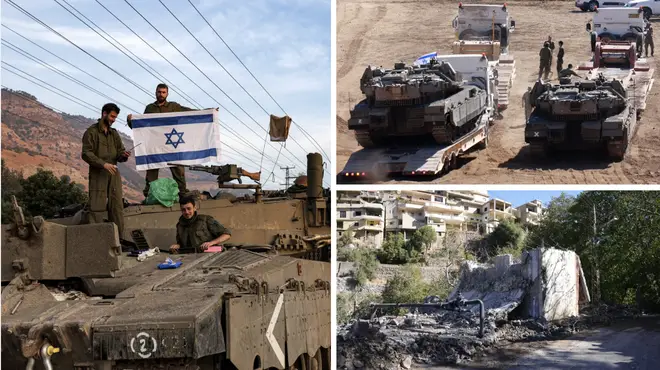
The mass of Israeli tanks and armoured personnel carriers was impossible to hide.
Dozens of beige-coloured military vehicles had assembled in a dirt field in northern Israel, a few miles away from the border with Lebanon.
Follow latest: Frontrunner to replace Hezbollah leader ‘unreachable’ – reports
They appeared overnight earlier in the week but were gone the next day.
The only evidence of their presence was a few crates of empty ammunition cases and tank tracks in the soil.
It was unclear where the unit disappeared to but, with hundreds of rockets fired by Hezbollah into this part of the country in the past three days alone, it is unsafe to stay in the same location for long – whether or not the heavy armour was bound for southern Lebanon.
Later in the day, we drove closer to the border. It was possible to see Lebanese homes on the hilly terrain on one side and Israeli houses on the other – communities combined by geography but divided by war.
As we stood a few hundred metres away from the border, the sound of distant gunfire could be heard as Israeli ground troops battled against Hezbollah inside Lebanon.
There was also the boom of artillery rounds and the buzz of a drone overhead.
Advertisement
Blackened scorch marks scarred the ground around us – likely caused by some of the many Hezbollah rocket strikes in recent days.
The militant group – backed by Iran – began firing munitions into northern Israel the day after the 7 October atrocities in southern Israel by Hamas, which is also aligned with Tehran.
Since that moment, some 60,000 civilians have fled towns, villages and kibbutzim close to the border.
Enabling all these families to return is a key goal of the widened Israeli operation against Hezbollah, which began last month and expanded into a ground offence in the past few days.
We travelled to Kibbutz Dan, just over a mile from the border. Famous for trout farming, this used to be a vibrant community of around 700 people, including children who would race around on bikes or play in a large swimming pool.
Today, there are only about 150 residents left. Among them are Shaul and Bilha Givoni, aged 80 and 79 respectively.
He has lived in the kibbutz his whole life, including during the 1948 war that followed Israel’s establishment as a sovereign state.
At that time, as a child, he had been forced to evacuate.
“After that, I said – this is my home, no one will ever evacuate me again,” Shaul said.



